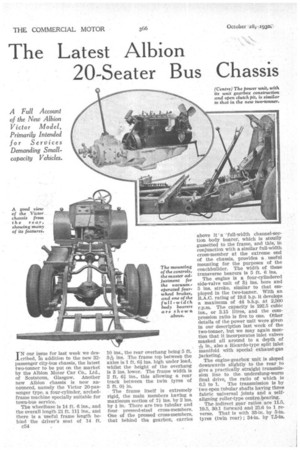The Latest Albion 20-Seater Bus Chassis
Page 112

Page 113

If you've noticed an error in this article please click here to report it so we can fix it.
IN our issue for last week we described, in addition to the new 32passenger city-bus chassis, the latest two-tonner to be put on the market by the Albion Motor Car Co., Ltd., of Scotstoun, Glasgow. Another new Albion chassis is now announced, namely the Victor 20-passenger type, a four-cylinder, arched. frame machine specially suitable for town-bus service.
The wheelbase is 14 ft. 6 ins., and the overall length 21 ft. 111 ins., and there is a useful frame length behind the driver's seat of 14 ft.
c54
10 ins, the rear overhang being 5 ft.
ins. The frame top between the axles is 1 ft. 6i ins, high under load, whilst the height of the overhang is a ins. lower. The frame width is 2 ft. 61 ins., this allowing a rear track between the twin tyres of 5 ft. N in.
The frame itself is extremely rigid, the main members having a maximum section of 71 ins. by 2 ins. by 1 in. There are two tubular and four pressed-steel cross-members, One of the pressed cross-members, that behind the gearbox, carries above it ' a 'full-width channel-section body bearer, which is stoutly gussetted to the frame, and this,• in conjunction with a similar full-width cross-member at the extreme end of the chassis, provides a useful mounting for the purposes of the coachbuilder. The width of these transverse bearers is 5 ft. 6 ins.
The engine is a four-cylindered side-valve unit of 3/ ins, bore and 5 ins, stroke, similar to that employed in the two-tonner. With an R.A.C. rating of 19.6 h.p. it develops a maximum of 44 b.h.p, at 2,500 r.p.m. The capacity is 192.5 cubic ins., or 3.15 litres, and the compression ratio is five to one. Other details of the power unit were given in our description last week of the two-tonner, but we may again mention that it incorporates inlet valves masked all around to a depth of
in., also a Ricardo-type split inlet manifold with special exhaust-gas jacketing.
The engine-gearbox unit is sloped downwards slightly to the rear to give a practically straight transmission line to the underslung-worm final drive, the ratio of which is 6.5 to 1. The transmission is by two open tubular shafts having three fabric universal joints and a selfaligning roller-type centre.learing.
The indirect gear ratios are 11.5, 19.5, 30.1 forward and 25.6 to 1 reverse. That is with 33-in. by 5-in. tyres (twin rear) ; 34-in. by 7.54n.
All springs are shackled at their rear ends, the rear springs being underslung, with a cast axle chair which takes the braking torque. With Dewandre-vacuum assistance, the pedal applies brakes on all four wheels, and in every respect brake equipment corresponds with that on the two-tonner described in our issue last week, the drums being 17 ins, in diameter and the friction area aggregating 336 sq. ins.
The fuel tank is, however, located differently, being on the near side and strapped beneath brackets extending outwards from the framemember.




















































































































































































